Professor Yu Hongyu, the Executive Director of the SUSTech School of Microelectronics, shares his intention to build the School.
Last week, a lecture on China’s core technologies took place. The lecturer, Professor Yu Hongyu, is the Executive Director of the SUSTech School of Microelectronics (SME) and the Vice President of the Shenzhen Institute of Wide-bandgap Semiconductors.
Professor Yu Hongyu explored integrated circuits from a broad view, and then moved onto the historical development of integrated circuits in China and analyzed the current problems faced by the industry. The final stage of his lecture saw Professor Yu Hongyu introduce the School of Microelectronics and its research to the audience.
As the first Greater Bay Area university cooperation project to be hosted by SUSTech, the School is undoubted of landmark significance. To gain an in-depth understanding of the SME, we interviewed Professor Yu Hongyu.

Q: Would you please introduce the SUSTech School of Microelectronics?
A: The development of the Guangdong-Hong Kong-Macau Greater Bay Area (GBA) has become a major strategic deployment at the national level, which has also brought more development opportunities and broader development space to Southern University of Science and Technology (SUSTech).
China’s Ministry of Education (The Ministry) has officially approved the SUSTech School of Microelectronics as a National Exemplary School of Microelectronics. It is a significant achievement for Southern University of Science and Technology (SUSTech) that accelerates its development. With an innovation-based education philosophy, the School intends to cooperate with world-renowned universities located in Bay areas around the world.
This pronouncement required SUSTech to work towards the strategic needs of China and the GBA. It should explore different cooperative models and comprehensively enhance China’s microelectronics industry and integrated circuit personnel training. Another key point was for the School to make positive contributions to solving problems of industrial chip development in China.
The establishment of SME is also a response to the implementation of National Outline of the Development of Integrated Circuit Industry and the Notice on the Construction of National Exemplary School of Microelectronics.
The School serves the development of the microelectronics industry across the GBA. It seeks to deepen and develop collaborative industry-university research by exploring diversified talent pipelines that cultivate innovative talents perfect for the microelectronics industry. The School will promote integrated circuits, artificial intelligence (AI) and 5G mobile communications as their key areas of focus. It aims to develop into a high-level, international, research-oriented national exemplary microelectronics institute.
Nearly 500 million yuan will be invested into the Institute over a 5 year period, on top of the construction of the buildings associated with the School. This funding will support the development of scientific research, laboratories, micro and nano-research testing platforms, research centers, teaching resources, and other important issues.

Q: What was the intention behind launching the SUSTech School of Microelectronics?
A: In the new era, the integrated circuit industry is crucial for the transformation of China’s manufacturing industry and adaptation to the digital age. With Shenzhen at the center of China’s integrated circuit industry in so many ways, it was critical for a National Exemplary School of Microelectronics to be placed in Shenzhen.
This is why the support of the Ministry of Education is so significant. The construction of SME will enhance the quality of research into microelectronics technology. It will, therefore, aim to reduce the gap left from previous shortfalls in such educational and scientific infrastructure spends. This background shows that SUSTech is a pioneering institution, perfectly placed to host the School within the GBA, sharing its resources and bringing new development opportunities throughout the region.
Q: What advantages does the SME offer?
A: SUSTech’s rapid development has caught many eyes across mainland China and indeed the world. With its resources explicitly designed for microelectronics, undergraduates can undertake manufacturing training in the specially designed Advanced Clean Laboratories. Further to that, Shenzhen’s location next to Hong Kong provides mutual development opportunities.

One of the key aspects of the School is cross-border cooperation. By working together, the GBA will be improved through research and education at the Institute. Each partner offers their own complementary advantage, which will assist in the development of the School. Also, the joint training program offered by the Institute will work with SUSTech’s School of System Design and Intelligent Manufacturing to develop a program for the new era of engineering.
Q: How does the School plan to operate as an educational institution?
A: The importance is about how to form a high-quality talent pipeline for microelectronics. Our focus is on training leaders in integrated circuit engineering, whether they are leading players, senior design talents or core process engineers. These leaders would serve the local economy and the GBA’s development needs.
In line with SUSTech’s internationalization goals, the SME would seek to cooperate on a cross-regional basis to benefit the integrated circuit industry of the nation.
As for the curriculum, the school provides two major subjects, including Microelectronics Processes and Devices and Integrated Circuits and Systems. The School would also build IC design methods and several research centers in conjunction with industry. These industry-university research centers would serve Shenzhen’s needs in a real and practical way.

The Institute will also adopt SUSTech’s innovative training models to teach its students with a 1:10 teacher-student ratio. It will also follow SUSTech’s educator requirements, while hiring senior IC industry personnel as adjunct faculty.
Q: What are the unique features of the School?
A: The first is cross-border cooperation and collaborative construction. The second is the joint training program for “new engineering,” and the third is to establish an industry-based school and to carry out continuing education.
Q: What have you learned from the renowned microelectronics institutes around the world?
A: The microelectronics majors at top universities around the world, such as Stanford and MIT, are well-integrated with industry. SUSTech was chosen from 17 other colleges and universities, including Peking University and Tsinghua University, in mainland China as the National Exemplary School of Microelectronics.

Q: What are the goals of the SUSTech School of Microelectronics?
A: The School aims to take a global perspective and strive to achieve a higher standard. SUSTech’s scientific research and academic influence will give SME the most opportunities to take advantage of Shenzhen’s regional and industrial development. The School will carry out university and industry-level exchanges and cooperation to maximize its potential.
In the long run, the School aims to develop strategic emerging industries such as the third-generation semiconductor technology and the critical core devices of network communications in the future.
Q: What role will the SUSTech School of Microelectronics play in the construction of the GBA?
A: I believe that SME will play a vital role in the development of the GBA, particularly in enhancing cooperation in scientific and technological innovation. It will take advantage of geography and resources to improve collaboration across the GBA and rapidly modernize education, in its quest to develop a world-class microelectronics discipline.
Proofread ByChris Edwards, Xia Yingying
Photo BySUSTech Institute of Microelectronics